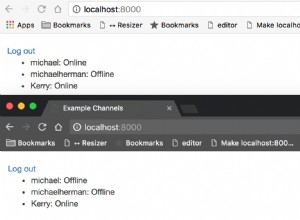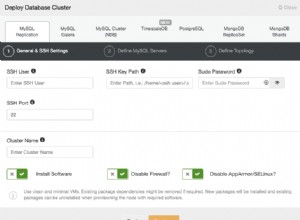Das ist etwas knifflig. Sie können Variablen verwenden, wie im folgenden Beispiel:
SELECT (
CASE cust_type
WHEN @curType
THEN @curRow := @curRow + 1
ELSE @curRow := 1 AND @curType := cust_type END
) + 1 AS rank,
cust_type,
cust_name,
revenue
FROM sales,
(SELECT @curRow := 0, @curType := '') r
ORDER BY cust_type DESC, revenue DESC;
Der (SELECT @curRow := 0, @curType := '') r part erlaubt die Variableninitialisierung, ohne dass ein separates SET erforderlich ist Befehl.
Testfall:
CREATE TABLE sales (cust_type varchar(10), cust_name varchar(10), revenue int);
INSERT INTO sales VALUES ('Top', 'A', 10000);
INSERT INTO sales VALUES ('Top', 'B', 9000);
INSERT INTO sales VALUES ('Top', 'C', 8000);
INSERT INTO sales VALUES ('Bottom', 'X', 5000);
INSERT INTO sales VALUES ('Bottom', 'Y', 6000);
INSERT INTO sales VALUES ('Bottom', 'Z', 7000);
Ergebnis:
+------+-----------+-----------+---------+
| rank | cust_type | cust_name | revenue |
+------+-----------+-----------+---------+
| 1 | Top | A | 10000 |
| 2 | Top | B | 9000 |
| 3 | Top | C | 8000 |
| 1 | Bottom | Z | 7000 |
| 2 | Bottom | Y | 6000 |
| 3 | Bottom | X | 5000 |
+------+-----------+-----------+---------+
6 rows in set (0.00 sec)
Ein weiterer Testfall:
CREATE TABLE sales (cust_type varchar(10), cust_name varchar(10), revenue int);
INSERT INTO sales VALUES ('Type X', 'A', 7000);
INSERT INTO sales VALUES ('Type X', 'B', 8000);
INSERT INTO sales VALUES ('Type Y', 'C', 5000);
INSERT INTO sales VALUES ('Type Y', 'D', 6000);
INSERT INTO sales VALUES ('Type Y', 'E', 4000);
INSERT INTO sales VALUES ('Type Z', 'F', 4000);
INSERT INTO sales VALUES ('Type Z', 'G', 3000);
Ergebnis:
+------+-----------+-----------+---------+
| rank | cust_type | cust_name | revenue |
+------+-----------+-----------+---------+
| 1 | Type Z | F | 4000 |
| 2 | Type Z | G | 3000 |
| 1 | Type Y | D | 6000 |
| 2 | Type Y | C | 5000 |
| 3 | Type Y | E | 4000 |
| 1 | Type X | B | 8000 |
| 2 | Type X | A | 7000 |
+------+-----------+-----------+---------+
7 rows in set (0.00 sec)
Sie können natürlich den cust_type bestellen aufsteigend statt absteigend. Ich habe absteigend verwendet, um Top zu haben vor Bottom im ursprünglichen Testfall.




